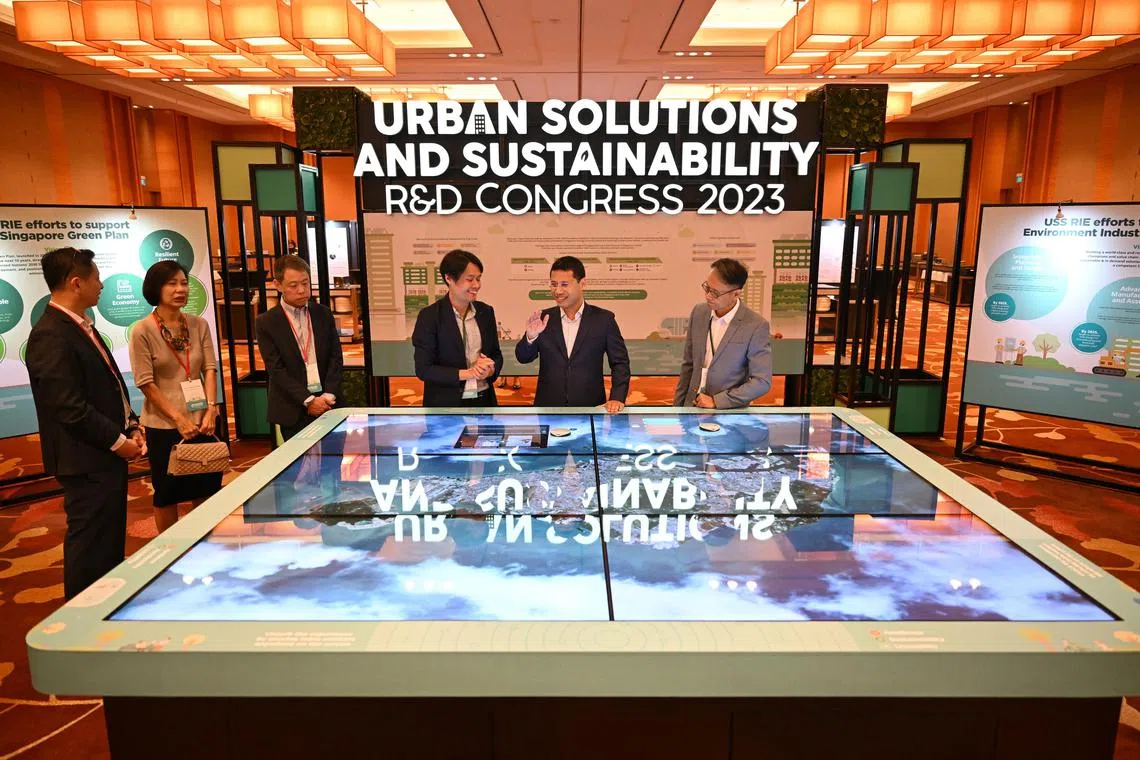Research projects on forest health, e-waste recycling aim to enhance Singapore’s sustainability
Sign up now: Get ST's newsletters delivered to your inbox

National Development Minister Desmond Lee (second from right) viewing the exhibition at the Urban Solutions & Sustainability R&D Congress on Oct 4.
ST PHOTO: SHINTARO TAY
Follow topic:
SINGAPORE – Over three years, scientists from Nanyang Technological University (NTU) will scrutinise the soil in forests and urban green spaces in Singapore to compare nutrient cycles and find out if the Republic’s greening efforts are on the right track.
Nutrient cycles – where plants take in and release nutrients throughout their growth and decomposition – are a crucial indicator of an ecosystem’s health. Nutrient flows can be affected by changes in weather, climate and urbanisation.
Through the $1.82 million project, the scientists at the NTU Asian School of the Environment plan to build baseline data on the rates of release of nutrients by dead leaves and soil in forests and parks to develop a protocol for long-term monitoring.
This is one of four research projects aimed at enhancing Singapore’s sustainability and urban planning that were announced by National Development Minister Desmond Lee on Wednesday.
“This will enable us to better understand the impact of our City in Nature efforts, and help us to refine our urban greening strategies,” said Mr Lee at the Urban Solutions and Sustainability R&D Congress held at Sands Expo and Convention Centre.
Findings from the nutrient cycle project will be used to create models showing cycling rates in different environmental conditions and land management scenarios to find ways to improve a park or nature reserve’s resilience and health.
Two other research projects involve academic institutes working with government bodies to improve urban planning.
The Urban Redevelopment Authority and the Singapore University of Technology and Design are in a five-year programme to help urban planners become better decision-makers amid development constraints.
And on Wednesday, the Centre for Liveable Cities (CLC) and the Singapore-ETH Centre inked an agreement to share knowledge and translate scientific know-how into policies to improve planning and development.
CLC managing director Hugh Lim said that the partnership could address the challenges in urban planning that will come with an ageing population and climate change.
He said: “For people as they age, how would the urban systems evolve to better support them? And as our city ages, some of the infrastructure will also need to be renewed. When is the right time to do it so that it doesn’t disrupt how we function?”
The fourth research project aims to extract as much valuable metal as possible from used lithium-ion batteries and solar panels through more cost-effective and sustainable methods.
Between 2018 and 2023, scientists from NTU and the French Alternative Energies and Atomic Energy Commission (CEA) developed novel ways to recycle e-waste, such as using orange and other citrus fruit peels to break down and recycle lithium-ion batteries.
Now, the scientists have been given $17 million through the National Environment Agency to scale up their solutions at the industrial stage.
Their battery recycling process involves shredding used batteries and separating the plastics and the metals such as copper and aluminium. The recovered black mass is dissolved in concoctions derived from highly acidic fruit peels. Eventually, from there, metals used for battery electrodes, such as cobalt, lithium and nickel, are precipitated as metal salts.
After demonstrating this process in a 10-litre reactor over the past five years, the scientists are now working with local e-waste recycler Se-cure Waste Management to treat one tonne of black mass each day, said Professor Madhavi Srinivasan, co-director of the NTU Singapore-CEA Alliance for Research in Circular Economy, or Scarce.
The e-waste project also covers solar panels. The researchers are working with Maxeon Solar Technologies, a local solar panel manufacturer, to recycle one tonne of solar panels a day within five years.
About 80 per cent of a solar panel can be easily recycled after dismantling its aluminium frame and glass. It is the remaining 20 per cent – a flat sandwich structure with high-grade silicon and silver – that has been tricky to recover, said Dr Jean-Christophe Gabriel, the other co-director of Scarce.
Over the past five years, the team has developed processes to recover silicon from the structure.
Mr Lee said: “The pace of innovation has also accelerated, and while we pursue new ideas, industry adoption remains crucial.”
The nutrient cycle and e-waste projects are part of and funded by the urban solutions and sustainability arm of Singapore’s $25 billion five-year Research, Innovation and Enterprise plan, or RIE2025.
At the research and development congress, Mr Lee also gave an update on the built-environment scene, with more details to be announced later.
A Centre of Innovation for Built Environment – Robotics and Automation will be set up to help businesses adopt and develop robotics and automation technologies. The centre will be led by Temasek Polytechnic and Ngee Ann Polytechnic.
The Building and Construction Authority will also launch an innovation hub at its Braddell campus in October, for innovators to showcase their solutions and test-bed them.


